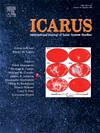Investigating grain size in the Martian mantle: Implications of basal mantle layers and viscoelastic models
IF 2.5
2区 物理与天体物理
Q2 ASTRONOMY & ASTROPHYSICS
引用次数: 0
Abstract
This study examines the grain size in the Martian mantle using viscoelastic dissipation models and two interior structural configurations: S23M1 (without a basal mantle layer, BML) and S23M2 (with a BML). Results indicate substantial variations in grain size estimates depending on the viscoelastic model employed. For instance, Andrade(μ-β) models suggest smaller grain sizes (∼1 mm), while Burgers(background), Burgers(+peak), and Andrade(fixed β) models predict a broader range of 0.1–10 cm. Sundberg-Cooper models, by contrast, yield larger grain sizes (>0.5 cm). The inclusion of a BML generally leads to smaller grain size estimates. For instance, Sundberg-Cooper predictions decrease from ∼10 cm to ∼0.8 cm with a BML, attributed to altered average rigidity of Mars that reduces elastic response. These findings stress the importance of mantle structure in interpreting viscoelastic properties and reconciling laboratory-derived constraints with geophysical observations. Future tidal measurements are critical for refining these models further.
研究火星地幔的颗粒大小:基底地幔层和粘弹性模型的含义
本研究使用粘弹性耗散模型和两种内部结构配置:S23M1(无基底地幔层,BML)和S23M2(有基底地幔层)来研究火星地幔的粒度。结果表明,根据所采用的粘弹性模型,颗粒尺寸估计存在实质性变化。例如,Andrade(μ-β)模型预测的颗粒尺寸较小(~ 1毫米),而Burgers(背景)、Burgers(+峰值)和Andrade(固定β)模型预测的范围更广,为0.1-10厘米。相比之下,桑德伯格-库珀模型的晶粒尺寸更大(0.5厘米)。包含BML通常会导致较小的晶粒尺寸估计值。例如,Sundberg-Cooper预测的BML从10厘米下降到0.8厘米,这是由于火星的平均刚度改变了,减少了弹性响应。这些发现强调了地幔结构在解释粘弹性性质和调和实验室推导约束与地球物理观测中的重要性。未来的潮汐测量对于进一步完善这些模型至关重要。
本文章由计算机程序翻译,如有差异,请以英文原文为准。
求助全文
约1分钟内获得全文
求助全文
来源期刊

Icarus
地学天文-天文与天体物理
CiteScore
6.30
自引率
18.80%
发文量
356
审稿时长
2-4 weeks
期刊介绍:
Icarus is devoted to the publication of original contributions in the field of Solar System studies. Manuscripts reporting the results of new research - observational, experimental, or theoretical - concerning the astronomy, geology, meteorology, physics, chemistry, biology, and other scientific aspects of our Solar System or extrasolar systems are welcome. The journal generally does not publish papers devoted exclusively to the Sun, the Earth, celestial mechanics, meteoritics, or astrophysics. Icarus does not publish papers that provide "improved" versions of Bode''s law, or other numerical relations, without a sound physical basis. Icarus does not publish meeting announcements or general notices. Reviews, historical papers, and manuscripts describing spacecraft instrumentation may be considered, but only with prior approval of the editor. An entire issue of the journal is occasionally devoted to a single subject, usually arising from a conference on the same topic. The language of publication is English. American or British usage is accepted, but not a mixture of these.
 求助内容:
求助内容: 应助结果提醒方式:
应助结果提醒方式:


